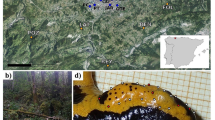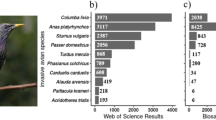Abstract
Ectothermal organisms distributed along environmental gradients in a wide geographical distribution display extensive phenotypic variation. This is particularly pervasive along latitudinal clines, which are linked to gradual changes in environmental factors. Widespread species may also be distributed among biogeographic breaks, which in contrast to smooth clines, often show abrupt changes in phenotypic traits. In species with widespread latitudinal distribution that also encompass important biogeographical breaks, it is not clear which of those factors prevails on shaping the phenotypic variation or if some traits are particularly more sensitive to one or the other. To evaluate this, we measured 4 fitness-related traits in 6 populations of the intertidal snapping shrimp Betaeus truncatus, as its distribution along Chile expands over 40° in latitude and three major biogeographical provinces. Here, we statistically evaluated the role of both, latitude and biogeographic breaks, on mean population values of fitness-related traits but also on the variances and covariances (i.e., P-matrix) between them. Overall, our results (1) indicate that latitude is more important than breaks in shaping the phenotypic variation of most of these fitness-related traits, (2) show that the differences in the variance–covariance relationship among traits between the extremes of the gradient arises from gradual increases in variance and rather sharp changes in covariance at mid-latitudes and (3) show that at present, it is difficult to unambiguously determine whether natural selection or plasticity is responsible for the observed pattern in means, variances and covariances and only further work might disentangle these possibilities.



Similar content being viewed by others
References
Albornoz L, Wehrtmann IS (1997) Descripción y clave de los primeros estadíos larvales de camarones carídeos (Decapoda: Hippolytidae, Alpheidae, Rhynchocinetidae) de aguas costeras de Chile. Invest Mar Valparaíso 25:121–133
Arntz W, Gorny M (1996) Cruise report of the Chilean–German–Italian Magellan “Victor Hensen” Campaign in 1994. Ber Polarforsch 190:1–113
Ayrinhac A, Debat V, Gibert P, Kister AG, Legout H, Moreteau B (2004) Cold adaptation in geographical populations of Drosophila melanogaster: phenotypic plasticity is more important than genetic variability. Funct Ecol 18:700–706
Bates D, Maechler M, Bolker B (2013). lme4: linear mixed-effects models using S4 classes. R package version 0.999999-2. http://CRAN.R-project.org/package=lme4
Bauer RT (1992) Testing generalization about latitudinal variation in reproduction and recruitment patterns with sicyoniid and caridean shrimp species. Invertebr Reprod Dev 22:193–202
Bernardo J (1996) The particular maternal effect of propagule size, especially egg size: patterns, models, quality of evidence and interpretations. Am Zool 36(2):216–236
Brante A, Fernández M, Viard F (2012) Phylogeography and biogeography concordance in the marine gastropod Crepipatella dilatata (Calyptraeidae) along the southern eastern pacific coast. J Hered. doi:10.1093/jhered/ess030
Camus PA (2001) Biogeografía marina de Chile continental. Rev Chil Hist Nat 74:587–617
Cardenas L, Castilla JC, Viard F (2009) A phylogeographic analysis across three biogeographic provinces of the southeastern Pacific: the case of the marine gastropod Concholepas concholepas. J Biogeogr 36:969–981
Clarke A (1987) Temperature, latitude and reproductive output. Mar Biol 38:89–99
Clarke A (1992) Reproduction in the cold: Thorson revisited. Invertebr Reprod Dev 22:175–184
Clarke A, Hopkins CCE, Nilssen EM (1991) Egg size and reproductive output in the deepwater prawn Pandalus borealis Krøyer, 1838. Funct Ecol 5:724–730
Conover DO, Duffy TA, Hice LA (2009) The covariance between genetic and environmental influences across ecological gradients. Ann NY Acad Sci 1168:100–129
Cowen RK, Paris CB, Srinivasan A (2006) Scaling connectivity in marine populations. Science 311:522–527
Fox CW, Czesak ME (2000) Evolutionary ecology of progeny size in arthropods. Annu Rev Entomol 45:341–369
Hamilton AM, Klein ER, Austin CC (2010) Biogeographic breaks in Vanuatu, a nascent oceanic archipelago. Pac Sci 64:149–159
Haye PA, Varela AI, Thiel M (2012) Genetic signatures of rafting dispersal in algal-dwelling brooders Limnoria spp. (Isopoda) along the SE Pacific (Chile). Mar Ecol Prog Ser 455:111–122
Hoffmann AA, Sgro CM (2011) Climate change and evolutionary adaptation. Nature 470:479–485
Huey RB, Gilchrist GW, Carlson ML, Berrigan D, Serra L (2000) Rapid evolution of a geographic cline in size in an introduced fly. Science 287:308–309
Kingsolver JG, Izem R, Ragland GJ (2004) Plasticity of size and growth in fluctuating thermal environments: comparing reaction norms and performance curves. Integr Comp Biol 44:450–460
Krzanowski WJ (1979) Between-group comparisons of principal components. J Am Stat Assoc 74:703–707
Lande R, Arnold SJ (1983) The measurement of selection on correlated characters. Evolution 36:1210–1226
Lardies MA, Castilla JC (2001) Latitudinal variation in the reproductive biology of commensal crab Pinnaxodes chilensis (Decapoda: Pinnotheridae) along the Chilean coast. Mar Biol 139:1125–1133
Lardies MA, Wehrtmann IS (1997) Egg production in Betaeus emarginatus (H. Milne Edwards, 1837) (Decapoda: Alpheidae): fecundity, reproductive output and chemical composition of eggs. Ophelia 49:165–174
Lardies MA, Wehrtmann IS (2001) Latitudinal variation in the reproductive biology of Betaeus truncatus (Decapoda: Alpheidae) along the Chilean coast. Ophelia 55:55–67
Lardies MA, Medina M, Correa J (2008) Breakage of intraspecific patterns in coastal zones associated with copper mine tailings in Chile: the snapping shrimp Betaeus emarginatus as model. Mar Ecol Prog Ser 358:203–210
Lardies MA, Arias MB, Bacigalupe LD (2010) Phenotypic covariance matrix in life-history traits along a latitudinal gradient: a study case in a geographically widespread crab on the coast of Chile. Mar Ecol Prog Ser 412:179–187
Lardies MA, Muñoz JL, Paschke KA, Bozinovic F (2011) Latitudinal variation in the aerial/aquatic ratio of oxygen consumption of a supratidal high rocky-shore crab. Mar Ecol 32:42–51
Macaya EC, Zuccarello GC (2010) Genetic structure of the giant kelp Macrocystis pyrifera along the southeastern Pacific. Mar Ecol Prog Ser 420:103–112
Meneses I, Santelices B (2000) Patterns and breaking points in the distribution of benthic algae along the temperate Pacific coast of South America. Rev Chil Hist Nat 73:615–623
Mitchell-Olds T, Willis JH, Goldstein DB (2007) Which evolutionary processes influence natural genetic variation for phenotypic traits? Nat Rev Genet 8:845–856
Mizera F, Meszéna G (2003) Spatial niche packing, character displacement and adaptive speciation along an environmental gradient. Evol Ecol Res 5:363–382
Ovaskainen O, Cano JM, Merilä J (2008) A Bayesian framework for comparative quantitative genetics. Proc R Soc Lond B 275:669–678
Pearse JS, McClintock JB, Bosch I (1991) Reproduction of Antarctic benthic marine invertebrates: tempos, modes, and timing. Am Zool 31(1):65–80
R Development Core Team (2009) R: a language and environment for statistical computing. R Foundation for Statistical Computing, Vienna Austria
Ragionieri L, Fratini S, Vannini M, Schubart CD (2009) Phylogenetic and morphometric differentiation reveal geographic radiation and pseudo-cryptic speciation in a mangrove crab from the Indo-West Pacific. Mol Phylogenet Evol 52(3):825–834
Ricklefs RE, Wikelski M (2002) The physiology/life history nexus. Trends Ecol Evol 17:462–468
Rivadeneira MM, Fernandez M, Navarrete SA (2002) Latitudinal trends of species diversity in rocky intertidal herbivore assemblages: spatial-scale and the relationship between local and regional species richness. Mar Ecol Prog Ser 245:123–131
Robinson MR, Beckerman AP (2013) Quantifying multivariate plasticity: genetic variation in resource acquisition drives plasticity in resource allocation to components of life history. Ecol Lett 16(3):281–290
Roff DA, Prokkola JM, Krams I, Rantala MJ (2012) There is more than one way to skin a G matrix. J Evol Biol 25(6):1113–1126
Sanchez R, Sepulveda RD, Brante A, Cardenas L (2011) Spatial pattern of genetic and morphological diversity in the direct developer Acanthina monodon (Gastropoda: Mollusca). Mar Ecol Prog Ser 434:121–131
Sanford E, Kelly KW (2011) Local adaptation in marine invertebrates. Ann Rev Mar Sci 3:509–535
Sanford E, Roth MS, Johns GC, Wares JP, Somero GN (2003) Local selection and latitudinal variation in a marine predator–prey interaction. Science 300:1135–1137
Silva N, Rojas N, Fedele A (2009) Water masses in the Humboldt Current System: properties, distribution, and the nitrate deficit as a chemical water mass tracer for equatorial subsurface water off Chile. Deep Sea Res Part II 56:1004–1020
Stearns SC (1992) The evolution of life histories. Oxford University Press, Oxford
Takahashi Y, Morita S, Yoshimura J, Watanabe M (2011) A geographic cline induced by negative frequency-dependent selection. BMC Evol Biol 11:256
Tellier F, Meynard AP, Correa JA, Faugeron S, Valero M (2009) Phylogeographic analyses of the 30°S south–east Pacific biogeographic transition zone establish the occurrence of a sharp genetic discontinuity in the kelp Lessonia nigrescens: vicariance or parapatry? Mol Phylogenet Evol 53:679–693
Thiel M, Macaya E, Acuña E, Arntz W et al (2007) The Humboldt Current System of northern and central Chile: oceanographic processes, ecological interactions and socioeconomic feedback. Oceanogr Mar Biol Annu Rev 45:195–344
Thorson G (1950) Reproductive and larval ecology of marine bottom invertebrates. Biol Rev 25:1–45
Waters JM (2008) Driven by the west wind drift? A synthesis of southern temperate marine biogeography, with new directions for dispersalism. J Biogeogr 35(3):417–427
Wehrtmann IS, Carvacho A (1997) New records and distribution ranges of shrimps (Crusta cea: Decapoda: Penaeoidea and Caridea) in Chilean waters. Proc Biol Soc Wash 110:49–57
West BT, Welch KB, Gałecki AT, Gillespie BW (2007) Linear mixed models: a practical guide using statistical software. Chapman & Hall/CRC, Boca Raton
Zakas C, Binford J, Navarette SA, Wares JP (2009) Upwelling-driven community transitions reflected in limited barnacle gene flow. Mar Ecol Prog Ser 394:165–177
Acknowledgments
Aura M. Barria acknowledges a CONICYT Doctoral Fellowship. This research was funded by FONDECYT 1110743 to Marco A. Lardies, by CONICYT MEC 800120004 to Andrew P. Beckerman and by FONDECYT 1120461 to Leonardo D. Bacigalupe. This study complies with current Chilean legislation regarding the collection and treatment of invertebrates.
Author information
Authors and Affiliations
Corresponding author
Additional information
Communicated by P. Kraufvelin.
Rights and permissions
About this article
Cite this article
Barria, A.M., Lardies, M.A., Beckerman, A.P. et al. Latitude or biogeographic breaks? Determinants of phenotypic (co)variation in fitness-related traits in Betaeus truncatus along the Chilean coast. Mar Biol 161, 111–118 (2014). https://doi.org/10.1007/s00227-013-2319-0
Received:
Accepted:
Published:
Issue Date:
DOI: https://doi.org/10.1007/s00227-013-2319-0




